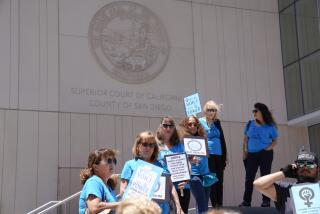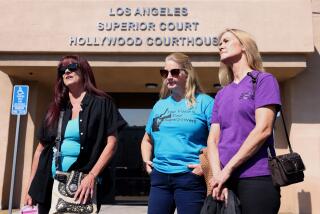Tips Offered on How to Use New CD-ROM on Sex Offenders
Three years after young Megan Kankaâs murder led to a national groundswell for more information on sex criminals living at large, a CD-ROM indexing Californiaâs worst offenders will arrive in Los Angeles County and across the state Tuesday morning.
The database contained on a single computer disc will be available at all Los Angeles County sheriffâs stations, as well as four Los Angeles Police Department divisions and Long Beach police headquarters. The only police departments to have the CD-ROMs are those in cities with populations of 200,000 or more. The packaging bears the name and face of the 7-year-old New Jersey girl whose July 1994 rape and murder led to the controversial law that created it.
Megan was killed by a paroled child molester living quietly in her New Jersey community. Below is a guide to the CD-ROM, which lists 63,920 offenders categorized as high-risk and serious.
Who can use the CD-ROM? Any citizen 18 or older with valid identification can use the database unless he or she is a convicted sex offender. The law that created the CD-ROM also says viewers must have an âarticulableâ reason to see the index, but that vague caveat has many local police shrugging when asked for a clear definition.
Visitors will be asked to fill out an application, and should expect to answer questions about their background, including their criminal history. There is no charge to view the CD-ROM.
What can I find out?: You can search for a particular sex offender by name, or you can look for registered sex criminals by ZIP Code. Other attributes can be used to narrow the search, including race, height and weight.
For each offender, the database lists a physical description (hair and eye color, tattoos, etc.), date of birth and criminal history. More than half the entries are accompanied by a photo. The CD-ROM includes 1,617 high-risk offenders, a category reserved for those who have been convicted of at least three felonies, including two violent offenses. The database contains photos of 80% of the stateâs high-risk offenders.
What canât I find out?: You cannot access the address of any offender beyond ZIP Code and the county in which he or she lives. Conviction records do not include the details of the crimes, such as location or victimâs name or age. Also, only sex crimes are included among the convictions.
How reliable is the information? Officials in recent months had said the information on the whereabouts of registered sex offenders may be incorrect in as many as 20% of the entries. But now that error estimate has swelled to as much as 40% or even 45%.
Local police say some of the sex criminals listed are either dead, incarcerated or have left the area.
Authorities say the system will improve in accuracy as the information is continually checked by police. The CD-ROM will be updated four times a year to keep listings as current as possible.
Can I print out data? No. The law forbids visitors from printing or photographing the screen, though you can write down notes.
How hard is it to use? Information is accessed with the âpoint and clickâ of a computer mouse. Also, at each site an investigator or staff member will assist visitors.
When can I use it? Each sheriffâs station will have a computer available from 8:30 a.m. to 3:30 p.m. Viewing there will be restricted to 15 or 30 minutes. The Los Angeles police have yet to finalize times for accessibility. In Long Beach, the terminal will be in the sex crimes office at police headquarters, but hours for viewing have not been set.
As of this weekend many agencies were making last-minute changes to their policies. It is best to check with the agency you plan to visit for details.
Do I have other options? If you cannot or do not want to use the CD-ROM technology, the California Department of Justice operates the 2-year-old Sex Offender Identification Line. For $10, callers can inquire about two individuals. The number is (900) 463-0400.
Times staff writers Nicholas Riccardi and Jeff Leeds contributed to this report.
(BEGIN TEXT OF INFOBOX / INFOGRAPHIC)
Digital Lineup
Beginning Tuesday, residents will be able to use a computer disc--called a CD-ROM--to find out about convicted sex offenders registered anywhere in California. Simple instructions guide users through the process; some police staffers may provide assistance.
Characteristics by which information can be searched:
Last name
First name
County
ZIP Code
Characteristics that can be used to narrow the search:
Sex
Ethnicity
Hair color
Eye color
Date of birth
Any range of height, and/or weight
*
Identifying Individuals
Once an individualâs file is found, other information will be available. An example:
INFO: Photograph (of most offenders and general description. Also, full name, ethnicity, hair, and eye color, date of birth, height and weight. Will also include the ZIP Code and county in which the person resides.
CHARGES: Details regarding conviction, child molestation or other sex offenses.
AKA: Alias or aliases used.
S/M/T: Scars, marks and tattoos that can help verify identification.
*
Where to Look
Three Los Angeles Police Department stations: Central Division at 251 E. 6th Street in downtown Los Angeles; West Los Angeles Division at 1663 Butler Ave. in West L.A.; Harbor Division at 2175 John Gibson Blvd. in San Pedro; Van Nuys Division at 6240 Sylmar Ave. in the San Fernando Valley. The LAPD is expected to add more locations later.
All 18 county sheriffâs stations. Call (213) 526-5441 for the address of a station near your.
Long Beach Police Department, 400 W. Broadway, Long Beach.
* Sources: California Department of Justice; local law enforcement agencies.
More to Read
Sign up for Essential California
The most important California stories and recommendations in your inbox every morning.
You may occasionally receive promotional content from the Los Angeles Times.










